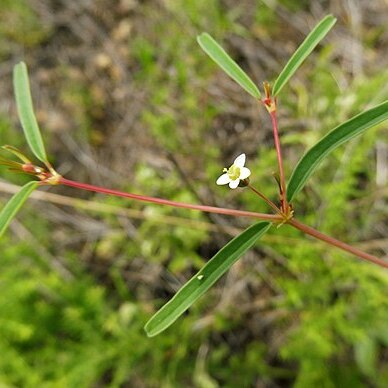Herbs, annual, with taproot. Stems erect or ascending, 10–60(–100) cm, glabrous, sometimes ± glaucous. Leaves opposite; stipules usually distinct, occasionally connate basally on one or both sides of stem, linear to triangular-subulate, usually deeply and irregularly fringed or lobed, rarely entire, 0.7–1.5 mm, glabrous; petiole 1–3 mm, glabrous; blade linear to narrowly oblong or narrowly lanceolate-oblong, (4–)8–30 × 3–7 mm, base symmetric or subsymmetric (usually narrower leaves), or slightly asymmetric and angled or short-tapered (wider leaves), margins entire, occasionally ± revolute, apex rounded to truncate, occasionally emarginate or mucronulate, abaxial surface pale green, adaxial surface light to bright green, both surfaces glabrous; venation obscure. Cyathia solitary or in small, cymose clusters these occasionally subtended by reduced, bractlike leaves at distal nodes or on congested, axillary branches; peduncle 1–5(–11) mm. Involucre broadly campanulate, 1.2–1.8 × 1.7–1.9 mm, glabrous; glands 4, yellowish green, broadly oblong to nearly circular, cupped or folded, 0.3–0.6 × 0.3–0.7 mm; appendages white or ± pinkish tinged, ovate to oblong-ovate, 0.4–2.5 × 1.1–1.7 mm, distal margin entire or slightly crenate or emarginate at tip. Staminate flowers 24–60. Pistillate flowers: ovary glabrous; styles 0.5–1.4 mm, 2-fid 1/2 length. Capsules broadly ovoid-globose, 1.9–2.5 × 2–2.5(–3) mm, glabrous; columella 1.8–2.1 mm. Seeds mottled whitish to brown, ovoid to broadly ovoid-triangular, bluntly 3-angled in cross section, 1.5–2 × 1.1–1.4 mm, smooth or slightly wrinkled.
More
Glabrous annual; stems decumbent to suberect, 1–6 dm, repeatedly forked; lvs linear to oblong, 1–3 cm, entire, obtuse to rounded or retuse; appendages ovate to oblong, conspicuous, more than twice as long as the glands; stamens 29–48 per involucre; fr strongly 3-lobed, 2–2.5 mm; seeds not compressed, smooth, roundly 3-angled, mottled white and brown, 1.5–2 mm. Rocky or sandy soil; Minn. to Mont., s. to Mo., Tex., and N.M. Summer. Var. missurica (E. zygophylloides; Chamaesyce z.; C. nuttallii), with scarcely angled seeds, capillary smaller branches, and capillary peduncles to 11 mm, occurs from Mo. to Tex. Var. intermedia (Engelm.) L. C. Wheeler (E. petaloidea; Chamaesyce p.) with definitely angled seeds, and stouter branches and peduncles, the latter to 4 mm, occurs from Minn. to Mont. and Tex.

